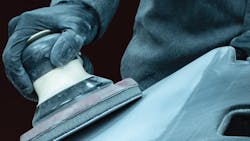Behind the Abrasive
In collision repair, every detail counts. From the tools used to the processes followed, success is determined by efficiently delivering high-quality results. One critical component often overlooked is abrasives.
Recent advancements in abrasive technology, such as film-backed abrasives, precision grain materials, and dust-free sanding systems, are changing the game. These innovations improve the technician's experience and enhance repair quality and shop efficiency.
Let's explore what's new in abrasives and how to leverage them in your body shop.
Advancements in Abrasive Technology
Let's first consider one of the most significant innovations in abrasives. Unlike traditional paper-backed abrasives, film-backed products provide a more uniform and consistent sanding surface. This evenness leads to better results, especially when blending and feather-edging, and extends the product's lifespan by reducing edge wear.
Precision grain abrasives also prove important. These abrasives wear evenly and maintain consistent cutting power over their lifespan. This means technicians can rely on predictable results from start to finish without worrying about uneven sanding or premature wear.
Advancements in abrasives also can help collision repair shops reduce waste and save money. For example, over three months, one body shop reduced its abrasive consumption by 3%. While that might not seem like much initially, it translated to significant cost savings.
Due to product performance and standard operating procedures (SOPs), after converting to new SEM Abrasive products with film-backing and precision grain we were able to show to improved performance and quality of repair. The combination of reduced material consumption and lower product costs created a win-win situation for the shop.
Surface Preparation: The Key to Success
Even the most advanced abrasives will fail if used improperly or on an unprepared surface. A common mistake in shops is technicians skipping critical steps in the preparation process, which can lead to product performance issues.
Surface preparation begins with cleaning. Contaminants such as wax, grease, or polish can interfere with sanding and lead to poor results. Before sanding, degrease the panel using a solvent- and water-based degreaser. A degreaser removes all residues, allowing the abrasive to work directly on the substrate.
Following the correct grit sequence is also critical. Skipping steps or jumping to a finer grit too quickly can leave behind scratches that become visible after painting. Follow the manufacturer's guidelines for grit progression to achieve a smooth, flawless surface.
Another best practice includes using guide coat products during sanding. These products help technicians identify low spots or leftover scratches. Applying a light mist of the guide coat and sanding until it's gone can ensure a properly leveled surface ready for the next step.
Dust-Free Sanding: Better Results
Dust-free sanding systems have become critical for body shops. These systems use abrasives designed with multiple holes that pair with vacuum-equipped sanders to capture dust. This helps keep the shop clean, improves repair quality, and supports a healthier technician work environment.
Dust-free systems minimize airborne particles to reduce the risk of contamination in the collision repair process. These systems can lead to cleaner repairs and a better finish, reducing rework. In addition, these systems create a healthier environment for technicians by reducing their exposure to dust, which can become a respiratory issue over time.
The Bottom Line
For body shops, adopting advanced abrasives can achieve better results with fewer resources. Film-backed abrasives, precision grain products, and dust-free sanding systems deliver cleaner and more efficient repairs while avoiding any repair redos. These innovations can help improve a shop's workflow when paired with proper training and adherence to standard operating procedures. The benefits for shops ready to explore the future of abrasives include improved repair outcomes for customers, healthier environments for technicians, and possibly greater long-term shop savings.
About the Author

Scott Barnes
Scott Barnes is the PPG manager of allied products strategic partnerships in automotive refinish. He is an expert in collision repair and abrasive technologies and has 26 years of experience helping shops improve their processes and outcomes
